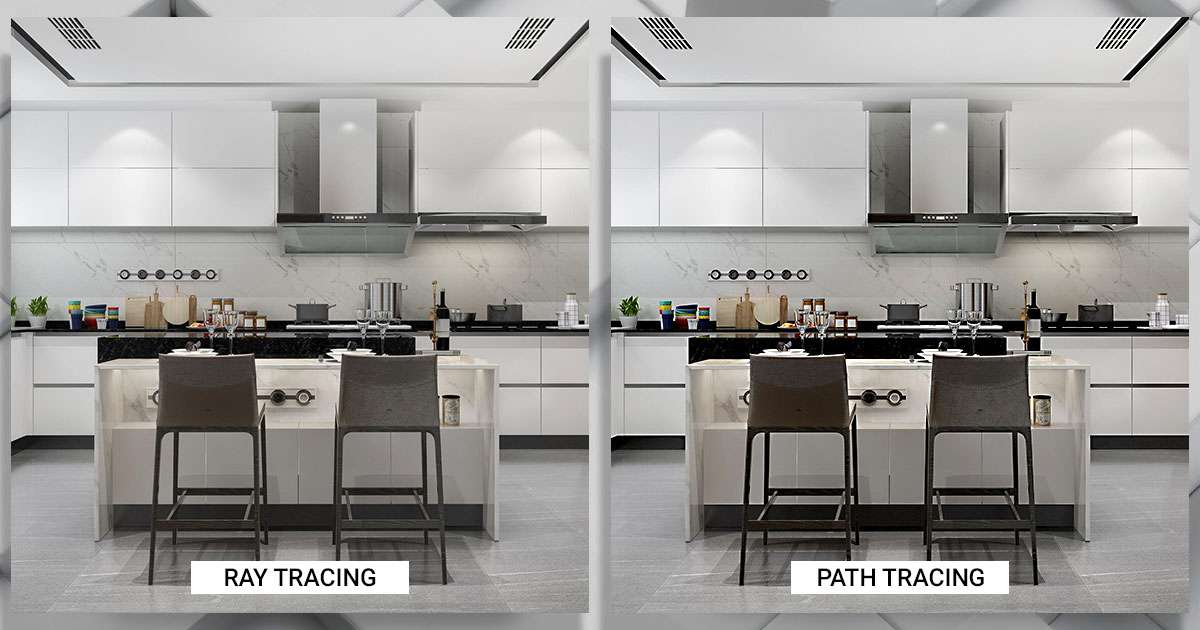Path Tracing vs Ray Tracing: The Differences in Realistic Rendering

In computer graphics and 3D rendering, two critical techniques are often talked about: path tracing and ray tracing. They both work to create very realistic images, but they do it in different ways. Understand how path tracing and ray tracing are different, what they’re good at, and when you might want to use one over the other.
What is ray tracing?
Ray tracing is a way to make pictures look real by following how light bounces off things in a virtual world. It calculates how light rays reflect, refracts, and make shadows. This makes reflections, see-through objects, and lighting effects look very lifelike.
Ray tracing has been used for a long time, especially in movies and fancy graphics. But now, with better graphics cards and technology, Ray tracing is worth it and is widely used in games to make them look more realistic.
Here are the benefits of using ray tracing:
- Realistic: Ray tracing makes images look real by showing how light interacts with objects.
- Reflections and Refractions: It can make shiny and see-through objects look real by showing accurate reflections and refractions.
- Shadows: Ray tracing creates realistic shadows, including soft shadows and shadows from see-through objects.
- Easy to Use: Ray tracing is simple to set up and can make high-quality images without needing lots of complicated settings.
- Versatile: It can be used in many ways, like in video games, movies, and architecture.
- Improving Performance: With better technology, ray tracing can be used in real time, making games and simulations more lifelike.
What is path tracing?
Path tracing is a fancy way to make pictures look real by following how light moves around. Instead of just tracing one light ray at a time, like in ray tracing, path tracing looks at all the possible paths that light can take as it bounces around. This includes how light shines directly on things, bounces off other surfaces, and makes special lighting effects.
Path tracing is harder for computers because they have to consider so many different light paths. But it gives much more accurate and lifelike results, especially in scenes with tricky lighting and materials. It’s often used in movies and animations, where making things look super natural is more important than how long it takes to make them.
Here are the benefits of path tracing:
- Realistic: Path tracing creates lifelike images by accurately simulating how light behaves.
- Accurate Lighting: It calculates all possible light paths, resulting in precise lighting and shadows.
- Versatile: Path tracing can handle various lighting conditions and materials, making it suitable for different needs.
- Consistent: It produces consistent results across different scenes and lighting setups.
- High Quality: Path tracing delivers high-quality images with realistic lighting effects.
- Future-Proof: It can take advantage of hardware advancements to improve rendering quality.
Path Tracing vs. Ray Tracing: The Differences
While both path tracing and ray tracing aim to simulate the behavior of light in a scene, they differ in their approach and complexity. Here are some key differences between the two techniques:
- Lighting Accuracy: Path tracing is better at simulating how light behaves because it considers all possible light paths, including indirect and global illumination effects. Ray tracing, on the other hand, usually only looks at direct illumination and some simple indirect lighting, which can lead to missing or incorrect lighting effects in complex scenes.
- Rendering Time: Path tracing is slower and needs more computing power than ray tracing because it thinks about many different light paths. Ray tracing is faster but may not be as accurate, especially in scenes with tricky lighting and materials.
- Visual Quality: Path tracing makes images more realistic and accurate, especially in scenes with lots of different lighting effects like reflections, refractions, and caustics. Ray tracing can also make high-quality images but might struggle with some lighting effects and complex materials.
- Complexity: Path tracing is more computationally complex than ray tracing due to its probabilistic nature and the need to trace multiple light paths. Ray tracing, being a simpler technique, is faster but may not produce as realistic results as path tracing.
- Use Cases: Ray tracing is often used in video games where speed is important. Path tracing is more common in movies and animations, where getting things to look just right is more important than how long it takes to make them.
Applications of Path Tracing and Ray Tracing
Path tracing and ray tracing are used in a wide range of applications in computer graphics and visualization. Some typical applications include:
- Video Games: Ray tracing is used in video games to create realistic lighting effects and improve visual quality.
- Movies: Both path tracing and ray tracing are used in movie production to render CGI scenes and special effects.
- Architectural Visualization: Path tracing and ray tracing are used in architectural visualization to create realistic renderings of buildings and interiors.
- Product Design: Path tracing and ray tracing are used in product design to create realistic renderings of products before they are manufactured.
Ray Tracing vs. Path Tracing: Which is better?
As technology improves, ray tracing will become more popular for games, making them look even better and run smoothly. Path tracing will likely stay the best way to make movies and fancy graphics look incredibly real, but it might also be used more in real-time applications as computers get faster.
In the end, whether to use path tracing or ray tracing will depend on what you need for your project, how fast your computer is, and how important it is for things to look real versus running smoothly.

